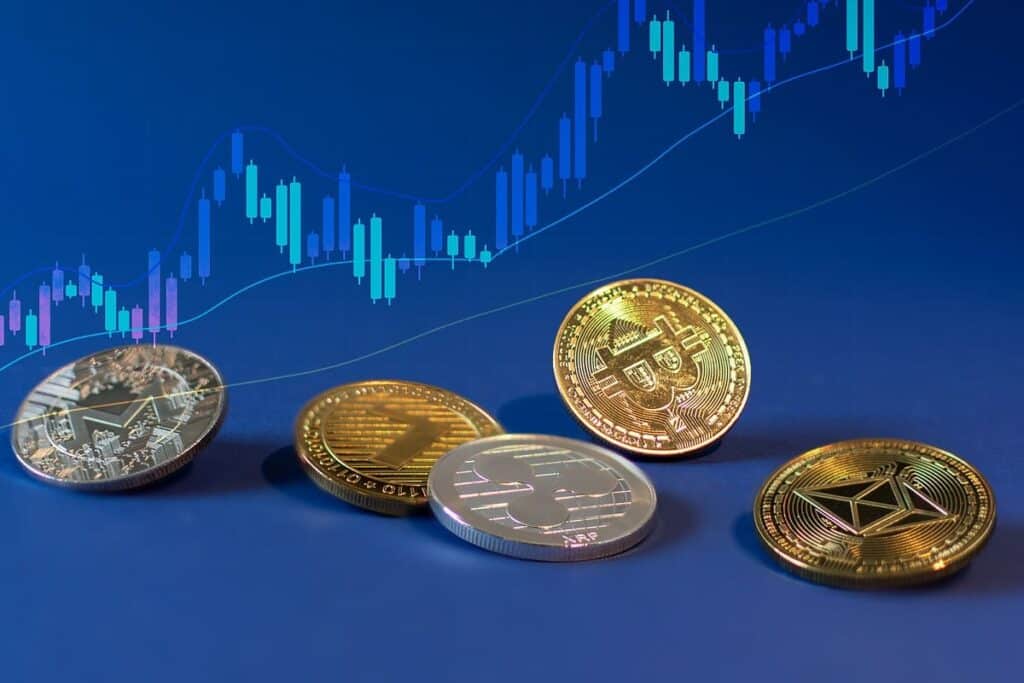What You’re Investing in With Coinbase Stock
Table of contents

Bitcoin miners are going to be up Schitt’s Creek without a paddle if the Web 3.0 community decides that conserving the electricity used to mine bitcoins is more important than the joys of decentralized finance. That’s the direction Ethereum 2.0 is going, so nothing says bitcoin couldn’t make the same move. It takes about $12,500 dollars to mine a single bitcoin which you can then sell to a greater fool crypto investor for (checks Coinbase) $41,953.

Just make sure you don’t use Tether to conduct your transaction because that cryptocurrency has systemic risk that’s almost too incredulous to believe.
If you want exposure to blockchain and crypto, there are few good ways to get it when it comes to equities. We recently vetted The Amplify Transformational Data Sharing ETF (BLOK) and found mostly a bunch of bitcoin miners along with the usual names like Silvergate, MicroStrategy, and Coinbase. Other names like NVIDIA and CME Group are less compelling ways to get blockchain exposure. Nonetheless, few investors today seem to understand what they’re investing in as 1 in 10 Americans dabbles in the 8,000 cryptocurrencies readily available, thanks to the proliferation of free trading apps.
Robinhood likes to talk about democratizing access to wealth when in fact they’re pissing on investors’ shoes and telling them it’s raining. Robbin-the-hood makes the most of their money from peddling cryptocurrencies and options to retail investors who – on average – carry an account balance of just $240. These small account balances lead to risky bets and mistakes that are usually repeated when the next round of stimmy checks arrives.
An investment in Robinhood as it exists today is a bet on the irrational behavior of the Reddit types as they desperately pursue whatever get-rich-quick shitecoin being peddled to them by Web 3.0 “thought leaders.” Unfortunately, you’re making a similar bet with Coinbase Global Inc.
About Coinbase Stock
Last February we wrote a piece on Why We’re Liking Coinbase Stock At $128 a Share in which we praised the apolitical stance of the company’s CEO, Bryan Armstrong. That was prior to the initial public offering (IPO) and we suspected that shares would come out of the gate overheated. Indeed, they did, but that’s quickly changed as Coinbase transaction revenues have absolutely soared. We concluded the piece by mentioning that Coinbase was “building some businesses to reduce the company’s reliance on transaction fees.” That’s what we want to focus on today.
We created our simple valuation ratio so that we can quickly and easily value companies based on revenue growth. We use annualized revenues (last quarter X 4) so that the ratio is more responsive to growth. Unfortunately, that doesn’t work so well in the face of extreme revenue volatility such as what’s taken place over the past year for Coinbase. Here’s what that ratio looks like using today’s market cap of $57.5 billion and the revenue numbers from each of the past four quarters.
- Q4-2020: 57.5 / 1.26 = 45
- Q1-2021: 57.5 / 7.2 = 8
- Q2-2021: 57.5 / 8.92 = 6
- Q3-2021: 57.5 / 5.2 = 11
Coinbase’s revenues are volatile because they’re entirely dependent on the fickle whims of retail investors who will eventually realize that the crypto market is not the stock market.
Update 01/21/2022: A subscriber suggested we use market caps that match the time frames so we’ve modified the above a bit. Since Coinbase only began trading in April 2021, we only have market cap values for 3 quarters. These are as follows (using market cap at IPO for Q1 and then end of time period for the rest):
- Q1-2021: 100 / 7.2 = 14
- Q2-2021: 63 / 8.92 = 7
- Q3-2021: 59.6 / 5.2 = 11
Retail vs. Institutional Investors
An initial look at the Q3-2021 Coinbase letter to shareholders appears promising. (This letter format is great by the way.) Institutional investors are depositing assets on the Coinbase platform at a scale that far outweighs retail investors now.

But the devil is in the details. Just look at the percentage of transaction fees coming from retail vs institutional investors.

While institutional investors may have double the crypto assets and trading volume as retail investors, they’re only contributing a fraction of transaction revenues. That means Coinbase’s fortunes are heavily reliant on the sporadic behavior of retail investors right now. For example, between Q2-2021 and Q3-2021, retail investor transaction fees plummeted -44%. What happens when all these speculators realize that getting rich trading cryptocurrencies is a fool’s errand? The house money effect isn’t helping things as crypto investors demand higher and higher returns while hoping their new-found wealth doesn’t evaporate into the hands of scammers and criminals.
Coinbase bulls will correctly point to the company’s expansion into other areas outside of just transaction fees. That’s certainly happening, but quite slowly. Last quarter, 12% of Coinbase revenues weren’t related to transaction fees.

Indeed, revenue streams outside of transactions are growing at a decent clip. Here’s a breakdown of revenue streams not related to transaction fees.

“Custodial fees” appear to be in sync with the amount of assets on the platform which makes sense. If crypto prices are falling, custodial fees will probably fall too. Blockchain rewards are largely driven by “staking,” and Ethereum 2.0, now makes up the majority of their staked assets. In our recent piece on Ethereum, we talked about how the Ethereum cryptocurrency platform has decided to move away from the energy-intensive activity of mining in favor of something called “staking.” Should the Ethereum 2.0 release go pear-shaped, then the “Blockchain rewards” revenue segment will probably suffer.
Investing in Coinbase Stock
Some ESG types won’t shut up about the unfair distribution of wealth, but fail to condemn Robinhood for making the problem even worse. We believe companies that mislead investors as to how wealth gets created should be condemned. Is Coinbase guilty of this? You could probably argue it either way. The reality is, we’re all adults who are responsible for our own investment decisions. If you believe Zack on Twitter who says you can day trade your way into a Lambo, that’s on you. Unless you’re born into money, accumulating wealth is a long, slow, boring process that also requires you to work your ass off for decades.
Coinbase provides enough rope for you to hang yourself if you choose. While their fees stop just short of highway robbery (not to mention the not-so-obvious spreads), they do provide a platform that allows us to safely invest in bitcoin or any other cryptocurrencies we choose. But right now, the firm’s overreliance on retail investors means the stock is too risky for our tastes. They’re also heavily dependent on two cryptocurrencies for over 40% of transaction revenues – Bitcoin (21%) and Ethereum (22%).
Operating expenses surpassed a billion dollars for Coinbase last quarter, and the need for retail investors to keep spending $50 a month on transaction fees is paramount. We’d be interested in taking another look at Coinbase once they’re able to sufficiently diversify their revenue streams so that the majority of revenues don’t come from retail investor transaction fees. Until then, we’re avoiding the stock.
Conclusion
Coinbase provides an excellent pick-and-shovel play on the growth of cryptocurrencies and their ilk but relies too heavily on retail transaction fees for a majority of their revenues. While subscription and services revenues are growing, they also come with their own risks. We like the idea of a pick-and-shovel play on cryptocurrencies but will be avoiding Coinbase shares until the firm has sufficiently diversified their revenue streams.
Sign up to our newsletter to get more of our great research delivered straight to your inbox!
Nanalyze Weekly includes useful insights written by our team of underpaid MBAs, research on new disruptive technology stocks flying under the radar, and summaries of our recent research. Always 100% free.















Excellent written article as usual, thank you. I am actually long Coinbase despite the concentration risk of its revenue. It’s a Call option on NFTs without having to buy an NFT, since Ethereum is the common currency used in the NFT market. Also, according to your valuation ratio, Coinbase would be below a 40 as long as it makes 1.43B at its current market cap. That’s less than what it makes in a single Quarter, and the crypto market is in a bit of a lull currently. That can easily heat up quick whenever the next best Monopoly Money, I mean, elegant, White Paper-authored crypto becomes available on the Coinbase platform.
Thank you very much for the kind words! Feedback always helps us know we’re on track.
Based on your thesis you could also just consider buying Ether, but maybe the smarter way is to bet on the broader space just in case Ether is displaced by some other cryptocurrency? Love your Monopoly money comment 😉 Indeed.
Yes, the valuation ratio is quite low now compared to what it was, but when revenues are this volatile, our simple ratio becomes less effective. Coinbase is a great pick-and-shovel play but we’re just a bit cautious about how dependent they are on retail investors. The crypto space grew extremely fast and Coinbase is clearly approaching it with a high tolerance for risk. If crypto continues its growth trajectory, they’ll indeed fare very well. But if it falters, that may present a good buying opportunity.
Great article, but why are your using the same valuation ratio across the four quarters? Market cap changes as a function of shares outstanding and share price, so likely would never remain the same over the course of 12 months.
It was meant to just show the change with one variable fixed, but you are right. It should reflect the market cap at the time the quarter ended. We’ll update those numbers here in a bit and see how that changes things.
Updated values have been added. Thank you for the comment.
You’re correct, however I don’t want to be exposed to the one-sided volatility of Ether or any other crypto. You do well when it goes up and lose your shirt when it goes down. The great thing with $COIN though is that it does well when Ether goes up AND down. Those transaction fees are implemented on both buy and sell orders, so it doesn’t really matter if the underlying Crypto is rising or declining, Coinbase always wins as long as there is volatility.
That’s a very good point.
That is what I thought initially too – that Coinbase is a marketplace that would benefit from the trades irrespective of whether crypto (especially Bitcoin and Ethereum) went up or down. But at least from what I can see, it is very much correlated to the movements of these cryptocurrencies?
Good comment. Coinbase actually has a decreasing dependency on bitcoin/ether as time goes on. But when the entire cryptocurrency space is correlated, then the movements of big and small names will affect Coinbase’s fortunes.
ARK has Coinbase as no 3 position with size $1B. So it is huge and that means ARK is very bullish on Coinbase.
COIN price: $191.58. 52 week range: $162.20 – $429.54.
Market cap: $41.9B. Revenue: Q3 2021: $1.3B. So P/S ratio = 8.
That seems to be the case.
Coinbase has now attractive price: $177. A few days ago it reached 52 week low: $155.92. P/S ratio = 7.3.
It seems Coinbase stock is a good bet on cryptocurrencies in general. If for some reason you cannot buy cryptocurrencies, then Coinbase is a great alternative.
Let’s be honest Stan. Is there anyone on this planet who can’t buy cryptocurrencies right now? 😉
The stock is definitely a better bet than the vast majority of crypto options out there, that’s for darn sure.
2 bearish articles at SA give us a red flag regarding Coinbase.
Coinbase is charging retail investors excessive fees and that is possible only when there is no competition, but competition is coming.
Coinbase is no 3 ARK position – $975M. Is it wise for ARK to bet so much on Coinbase ? I doubt it.
I think their rationale is simple: they see Coinbase as a leader and they like to bet on leaders.
We will have to wait a few years to provide definite answer if ARK’s bet on Coinbase is smart or dumb.
Indeed we will. Coinbase fees are excessive, make no mistake.
Yesterday COIN reached 52 week low: $40.83, but oday it is over $57.
ARK is buying significant amount of COIN: over 540,000 shares in the last couple of days.
However it has a big loss on COIN so far: average price it was paying on its positions is: $245.45 – $265.12.
So the loss is around 77%. In general ARK has only one good big bet: Tesla, all other big bets have huge losses.
It is obvious now their strategy does not work in the bearish market, it looks like disaster.
That’s incorrect. Losses only happen when you lock them in. It’s not over until the big beautiful woman with loads of health issues sings.